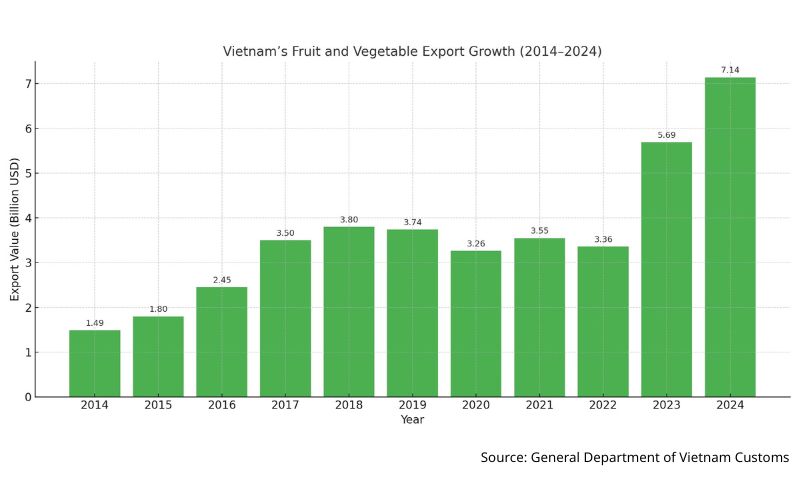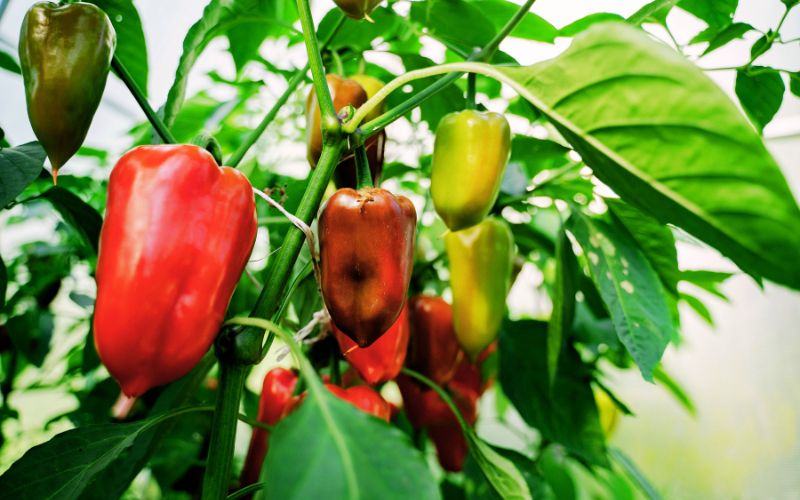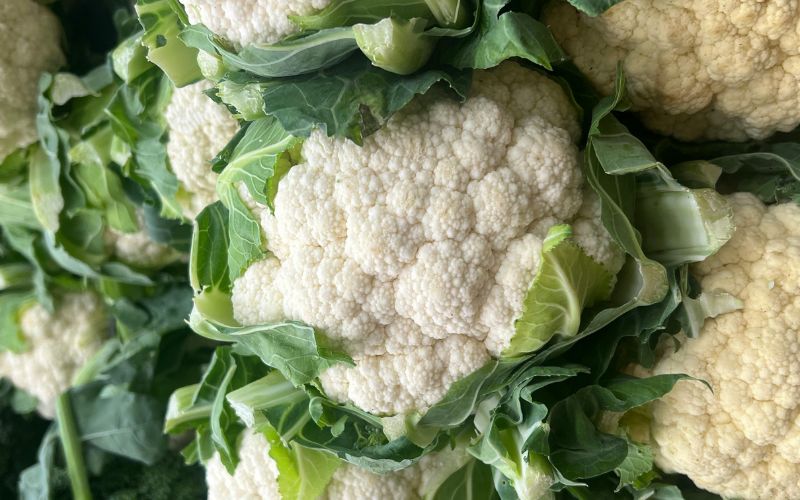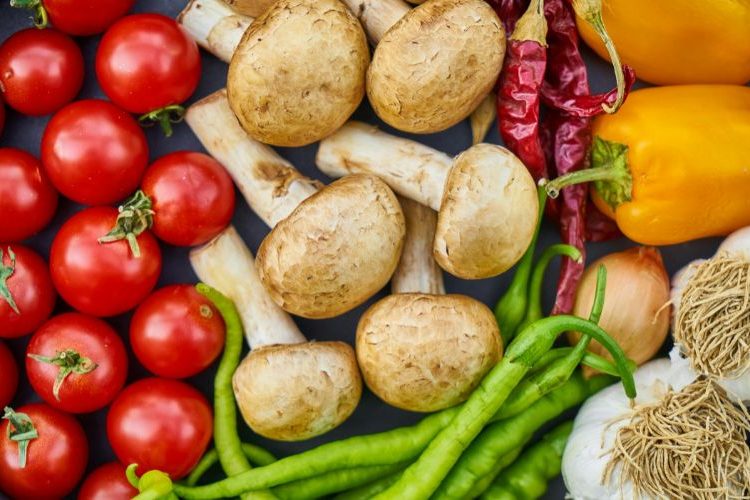Whether it’s fresh vegetables or value-added products like canned or ready-to-eat dried goods, Vietnam is steadily gaining attention from importers who want a reliable, diverse supply that’s easy to ship year-round.
Thinking about sourcing Vietnam vegetables but not sure where to begin? This guide will cover: where the best-growing regions are, which types of vegetables are in high demand, and what to keep in mind when it comes to quality control. Our goal? To help you get started with less guesswork and more confidence.
A Quick Look at Vietnam’s Vegetable Industry
Last year, Vietnam’s vegetable and fruit exports hit over $7 billion. But what really caught our attention is the long-term growth: just over a decade ago, that number was only about $1.49 billion. So in a little over ten years, the value has grown nearly five times.
When we look at where all that produce is going, China continues to be Vietnam’s top customer, year after year. In fact, Chinese buyers accounted for over 60% of the total export value last year. The U.S., South Korea, and Thailand are also major importers, each buying hundreds of millions of dollars worth of Vietnamese produce annually.

Looking ahead, according to a representative from the Vietnam Fruit and Vegetable Association, there’s a strong chance exports could reach nearly $8 billion this year if the momentum keeps going.
Why Should You Source Vegetables from Vietnam?
If you’re looking to source vegetables from Southeast Asia, Vietnam is definitely a name to keep on your radar.
1. Stable and Year-Round Vegetable Supply
One thing about Vietnam as a sourcing destination is that you can buy nearly every vegetable category from the country and never run out of seasonal availability. The country has a varied climate system with four seasons in the north, tropical wet–dry zones in the south, and temperate highlands in the center.
Such diversity allows for year-round cultivation across regions, with 28 different types in the north and 47 in the south. Here, you will find tons of:
- Leaf greens: bok choy, mustard greens, cabbage, and lettuce
- Root vegetables: carrots, sweet potatoes, taro, and radish
- Herbs and spices: coriander, basil, and lemongrass
- Fruiting vegetables: tomatoes, cucumbers, eggplants, and chili peppers
Meanwhile, Thailand, one of Vietnam’s closest competitors, mainly grows cool-climate vegetables like kale and cauliflower.
2. Low Chemical Residue and Faster Farm-to-Port Time
Vietnamese vegetables often contain lower pesticide residue due to cooler growing zones like Lam Dong that need fewer treatments. According to a 2022 residue study in Central Vietnam, 77% of vegetable samples from Central Vietnam were within safe MRL limits, aligned with EU and US standards.
The country also exports over 80% of its fruits and vegetables in fresh form. The average shipping time to the EU ranges from 30–35 days, which is around 10 days faster compared to inland China or India, where internal logistics add extra delays.
3. Vietnam Vegetable Comes At Competitive Export Pricing
Another advantage about sourcing Vietnamese vegetables is the lower base cost. The average export price of Vietnam vegetables in 2024 was US$1,108 per ton. This is lower than China’s US$1,250 and Thailand’s US$1,320 per ton.
Besides low labor cost (around US$3/hour) and shorter farm-to-port logistics, Vietnam is far ahead in free trade agreements. It has signed and activated 19 FTAs, including EVFTA, CPTPP, and RCEP. All are effective into the 2030s. In parallel, Thailand has signed 14 FTAs, and Indonesia only 7.
What does that mean for your businesses, though? Simply put, these agreements offer tariff reductions from 0 to 9% for fresh vegetable exports to the EU, Japan, South Korea, the UK, Australia, New Zealand, and ASEAN markets. In other words, you, if sourcing from Vietnam, will be able to cut import costs and stay competitive.
Commonly Grown and Exported Vegetables in Vietnam
That’s the big picture. So, what are the most common categories for sourcing from Vietnam? Below are the 4 common types:
1. Chili Peppers and All Things Spicy

Vietnam exports all kinds of chili products: fresh chilies, dried ones, and chili powder. In 2024 alone, Vietnam earned nearly $22 million from chili exports. Among export varieties, Golden Horn chili tops exported types by volume, followed by Celestial chili and Cayenne pepper.
Vietnam-grown chilies are known for their special bold heat. The biggest fans? Laos, China, and South Korea.
2. Sweet Potatoes
Sweet potatoes are a popular sourcing vegetable from Vietnam. The most exported varieties are Japanese sweet potatoes (both yellow and purple types), traditional purple sweet potatoes, and white sweet potatoes. The major export markets are Switzerland, Norway, and the Czech Republic.
3. Cauliflower and Napa Cabbage

Cauliflower brought in over 19 million dollars for the country, while napa cabbage added more than ten million. Both are cool-climate vegetables commonly grown in northern and highland regions of Vietnam, known for their dense heads, crisp texture, and export-quality size.
So, the thing about Vietnamese cauliflower is that it usually has bigger heads and longer stems than the ones from China. It also has a firm texture and holds well in cold-chain logistics.
Places like China, Japan, and South Korea are the top buyers of Vietnamese cauliflower and cabbage. These are followed by Southeast Asian countries like the Philippines, Malaysia, and Singapore.
4. Leafy Herbs and Aromatic Greens
Herbs like coriander, basil, mint, and parsley are also pretty popular in Vietnam’s export scene. They add a fresh, punchy flavor to sauces, salads, and ready-to-eat meal kits.
Leafy herbs and aromatics usually head to countries in the EU like the Netherlands, Spain, and Italy. Since the EU removed Vietnamese herbs from their list of produce that needs extra pesticide checks, it’s become even easier for local farmers to export these to Europe.
Main Vegetable-Growing Regions in Vietnam
So, where to source Vietnamese vegetables? To plan your sourcing strategy effectively, you must first look at regional climate conditions and crop specialization types. In general, Vietnam has three major vegetable-producing zones:
1. Lam Dong (Central Highlands)
Lam Dong is hands down one of the most important vegetable-growing regions in Vietnam. The province has over 40,000 hectares of land dedicated to vegetable farming, and in peak seasons, total output can reach millions of tons.
One area that really stands out is Da Lat. Thanks to its cool climate all year round, it’s ideal for growing temperate vegetables like cabbage, cauliflower, potatoes, carrots, lettuce, and tomatoes. You’ll also find a lot of beans here, along with a wide variety of mushrooms.
What’s great about Lam Dong is that many farms here are already using modern, high-tech farming methods. A lot of them are part of cooperatives and follow international standards like GlobalG.A.P., Organic, or HACCP. That’s why vegetables from this region are already being exported to places like the U.S., the Netherlands, and Japan.
2. Tien Giang (Mekong Delta)
Thanks to its fertile soil and crisscrossing rivers and canals, Tien Giang has everything needed for growing healthy, high-yield crops. Right now, there are over 23,000 hectares of land here being used for vegetables. That’s enough to supply huge volumes of fresh produce to southern Vietnam, and still have plenty left to ship to places like China, South Korea, and even Europe.
So, what kind of vegetables are we talking about? A whole variety. You’ll find aromatic herbs like basil, Vietnamese coriander, and Chinese celery. Then there are leafy greens like mustard greens, lettuce, and bok choy, plus flowering and vine vegetables like bitter melon, gourd, and cucumber.
3. Red River Delta (Northern Vietnam)
Up north, vegetable farming is a big deal too. The total growing area in this region is close to 470,000 hectares, with a yearly harvest of around eight million tons. Most of that comes from the Red River Delta, in places like Hanoi, Hai Duong, and Thai Binh.
The cool thing about this area is that it supports vegetable farming all year round thanks to its temperate climate and distinct seasons.
- In the summer (May to August), farmers grow water spinach, amaranth, and lots of herbs.
- Winter (November to February) is great for things like mustard greens, lettuce, spinach, coriander, cabbage, and root veggies like carrots and radishes.
- Spring and fall are a nice balance. You can find just about everything, from leafy greens to herbs and fruiting vegetables.
Top 3 Go-To Vietnam Vegetables Sourcing Companies
So, who should you talk to if you’re thinking about sourcing vegetables from Vietnam? Here are three pretty well-known companies that you’ll definitely want to check out:
1. Mekong Export
Mekong Export works directly with large, clean farming areas across the Mekong Delta. They’ve got massive cold storage so they can handle big orders and keep things fresh from farm to container. Everything they produce follows international standards like HACCP, FDA, and ISO.
Their top products? Spicy Celestial chili peppers (frozen) and fresh organic okra. All packed in sturdy cartons, and they usually ship within about twenty days.
2. ANTESCO (An Giang Fruit-Vegetables & Foodstuff JSC)
Located in An Giang, ANTESCO is all about growing and processing frozen tropical vegetables. They’ve got a solid setup that meets a bunch of global standards: BRC, HALAL, FDA, even SEDEX for social responsibility. Their factories can process up to seventy five thousand tons a year. And they’re already exporting to places like North America, Europe, and Asia.
What can you buy from them? Mostly IQF-frozen veggies like chopped baby corn, soybeans, okra, and taro. They also do canned products like beets, sweet corn, and okra, which are ready for cooking or eating straight from the tin.
3. Hung Hau Foods
Hung Hau Foods runs several large processing plants in Ho Chi Minh City and Dong Thap, with a total annual capacity of around tens of thousands of tons. Besides fresh produce, they also focus on value-added items – like IQF-frozen baby corn and lemongrass, or crunchy dried snacks made from sweet potato, fresh jackfruit, and banana.
Their production lines follow strict standards like the FDA, ISO 22000:2018, and HALAL. Today, you can easily find their products in more than forty countries, including China, South Korea, Russia, and Germany.
How Much Does It Cost to Source Veggies from Vietnam?
Minimum order quantities (MOQs) and FOB prices can vary a lot depending on the product, but here’s a general idea to help you plan:
| # | Product of Vietnam Vegetables | Typical MOQ | Estimated FOB Price
(USD/kg) |
| 1 | IQF Frozen Chili Pepper | 10 kg (sample) / 20,000+ kg | Approx. $0.80 – $1.50 |
| 2 | Dried Chili Pepper | 500 kg – 1,000 kg | $0.35 – $6.50 |
| 3 | Chili Powder | 10 kg – 20,000 kg | Around $1.70 |
| 4 | IFQ Frozen Baby Corn | 10,000 kg / 1x40ft container | ~ $0.65 |
| 5 | IFQ Frozen Okra | 10,000 kg / 20ft – 40ft container | $0.55 – $2.50 |
| 6 | Fresh Cauliflower | 20ft or 40ft container | Approx. $0.80 – $2 |
| 7 | Fresh Cabbage | 20,000kg | Around $0.3 |
Factors to Consider When Purchasing Vegetables from Vietnam
For sourcing from Vietnam, the process often starts with selecting reliable suppliers. Then, you’ll move to sample verification, price negotiation, and confirming MOQs, before finalizing shipping terms and quality checks.
Despite Vietnam’s strong position in fresh vegetable exports, there remain challenges. Some suppliers may lack advanced cold storage or export-grade packaging. So, it’s important that you factor in during procurement:
- GlobalGAP – Think of this as a passport for the vegetables. It lets you trace where they came from and how they were cultivated, which is really helpful if you need transparency from farm to export.
- SMETA – It looks at the human side of things. It makes sure the veggies were farmed or processed in ethical, fair working conditions. Basically, it’s about doing right by both people and the environment.
- Organic certifications (like USDA Organic or EU Organic) are important if you’re aiming for high-end or eco-conscious markets like the US and EU.
- You’ll also want to ask for food safety certifications like HACCP or ISO. These are relatively standard for processed vegetables and show the supplier is committed to hygiene and safety.
- Depending on your market, you might also need something like HALAL for Muslim countries or Fair Trade for socially aware consumers.
- And do not forget to confirm that the vegetables you want are actually allowed to be imported – like bird’s eye chili peppers, which are officially cleared for import into China.
Where to Source Vietnamese Vegetables: Best Alibaba Alternative
In Vietnam, most buyers source vegetables through agriculture-focused trade shows like HortEx Vietnam or Vietnam Foodexpo, where they can visit exporters’ booths and evaluate produce directly. Some also reach out to vegetable farms and manufacturers. Local sourcing agents are another option.
For small and mid-sized importers, the most common approach is to search for vegetable suppliers online. However, it’s not uncommon for those vegetable exporting companies to require large MOQs and full-container shipments (e.g., 10–20 tons).
Among these few structured sourcing options, VinaSources stands out as a purpose‑built, Vietnam‑based B2B sourcing platform. It helps global buyers like you connect directly with verified Vietnamese vegetable suppliers – no guesswork, no middlemen.

Here’s how VinaSources supports you in getting the job done, smoothly and transparently:
- You’ll only talk to trusted Vietnam vegetable suppliers: Everyone listed has already been checked for export licenses, product quality, and important certifications. So you know they meet international standards and you’re not wasting time.
- Low MOQs and factory-direct pricing: VinaSources suppliers typically accept smaller batches, sometimes as low as 500 kg or 1 ton per SKU. Prices are set by the factory, without hidden markups or middleman fees
- Requesting quotes is simple: Just tell us what you need (product type, quantity, target price, packaging, or anything else) and we’ll take care of getting the info you need.
- Full support, start to finish: From handling logistics to supplier follow-ups and paperwork, we’ve got your back so you don’t have to worry about the nitty-gritty.
So if you’re ready to source vegetables from Vietnam without the hassle, give us a shout. Contact to get a quote!
